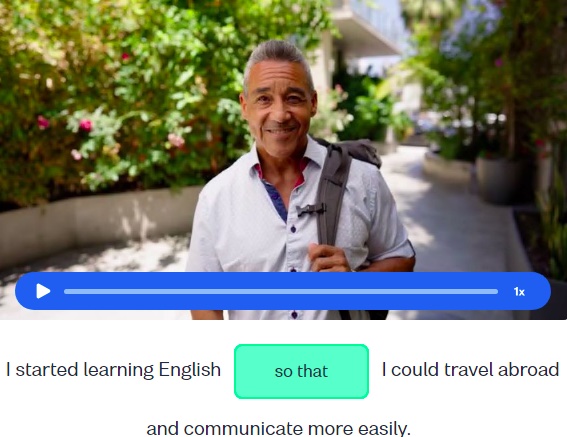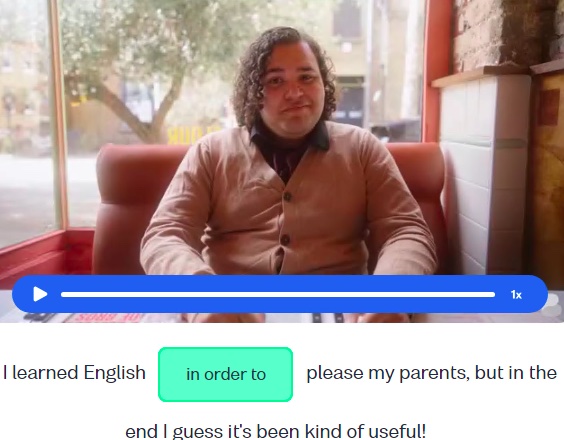A Guide to Conjunctive Adverbs
Learn how to build your texts with the help of conjunctive adverbs, the signs that will give clarity to your discourse.
I want to learn...
When speaking or writing English you will soon see that you need to connect your ideas to form a more coherent discourse. The words used to do that are conjunctive adverbs (like "also" and "for example"), and they will help the reader or listener to better understand the meaning of what you're saying. By using these words you will give signals like “I have several points to make” or “Now I’m going to say more of the same” and “I will be finished soon”.
These words are not only useful but they are necessary to build a text, especially if it’s written. These words will highlight the beginning of a new paragraph, the continuation of the last one or the conclusions that are about to come.
Building a text is an important step in your language learning and it will make a huge difference in your proficiency in English. So let’s dive right in and discover how to build the perfect text using conjunctive adverbs.
Want to become an expert in using conjunctive adverbs?
You will learn that the conjunctive adverb "so" is used to introduce the purpose or reason for the action described in the main clause ("I started learning English"). Become a pro and learn more conjunctive adverbs via free online exercises from Busuu!
What are conjunctive adverbs?
Conjunctive adverbs are versatile words that connect ideas within a sentence or between sentences. They serve as bridges, helping to guide the reader (or listener) through the logical flow of information presented by you.
The word “conjunctive” in fact means that they will put together the different parts of the discourse. Without them, a text will seem like an incoherent mix of thoughts that are not following any logical direction.
You might have noticed that we already used a few words that you could see on a map: “direction”, “bridges”. Conjunctive adverbs, essentially, work like a guide or a map through the text and we are going to divide them in three big categories: Straight ahead, U-turns and Milestones.
Straight ahead: Talking more about what I’ve said before
If you imagine your speech like a walk, these conjunctive adverbs will allow you to put one foot after the other. You will signal to your listener or reader that you are not done, you have more to add on your point. We can divide these adverbs into two categories. Let’s see them in depth with plenty of examples.
One plus one: Adverbs that add more
Here is a list of adverbs that will allow you to add points to your text:
-
also
Usage example: I don’t feel like going out tonight; also, it’s raining a lot. -
moreover
Usage example: The new software is user-friendly and efficient; moreover, it comes with advanced security features. -
for example
Usage example: To learn a new language you could do a variety of activities; for example you could start listening to music in your target language and study grammar in a fun and interesting way. -
for instance
Usage example: Learning a new language offers a number of cognitive benefits; for instance it improves memory and problem-solving skills.
See how these expressions help to add on what has been said previously? Also is basically a plus sign, very similar to moreover that is just a little bit more fancy, or as you say in proper linguistics lingo: a higher register.
Cause and consequence: Adverbs that put words in logical order
These adverbs will help you give a sense to your additional point explaining why they are connected to what was said previously:
-
so
Usage example: The weather reports predicted storms; so, we decided to reschedule the outdoor event. -
consequently
Usage example: The company was really close to bankruptcy and consequently it had to lay off part of its employees. -
as a result
Usage example: She forgot to charge her phone and as a result it went dead in the middle of the night and she was not woken by the alarm. -
hence
Usage example: The legal team found a breach of contract in the clients actions, hence, legal action was initiated.
Do you see the pattern here? This happened AND THEN this happened. Cause and consequence. Again, with a varying degree of fanciness. While you could read them all in writing, it is difficult to hear “hence” in an informal conversation, unless you would use it ironically.
U-turns: What is following is in contrast
On the flip side, there are conjunctive adverbs designed to introduce contrast or contradiction to what has been stated previously. These adverbs will signal that something unexpected happened.
Let’s look at the examples:
-
but
Usage example: She didn’t want to come, but, in the end she decided to join us. -
however
Usage example: The project was progressing without problems; however, a sudden change in leadership brought substantial difficulties. -
although
Usage example: Although the weather was unfavorable, they decided to go ahead with the outdoor event. -
on the other hand
Usage example: I enjoy the flexibility of freelancing; on the other hand, I miss the stability of a full-time job. -
conversely
Usage example: Early morning flights are usually quieter; conversely, evening flights tend to be busier and noisier.
These adverbs introduce opposing viewpoints and present alternative solutions or perspectives. It is interesting to note the position of although which typically goes at the beginning of a sentence ending with a comma and followed by another sentence. This structure conveys the contrast or concession made between the two sentences.
Milestones: Telling how to begin and where to end
Especially when it comes to writing, conjunctive adverbs play a crucial role in organizing information within a text. You will signal to the reader that there are a number of points to be dealt with, one last thing to talk about and your conclusions. You can use first, second, third…or go with the adverbs of this list:
-
on the one hand
Usage example: On the one hand, studying a foreign language will open new ways of communication and new possibilities to enjoy connections with people from different backgrounds. -
secondly
Usage example: Secondly, studying a foreign language will enhance your professional experiences making you more valuable in the job market. -
finally
Usage example: Finally, it will have a number of cognitive benefits on you: including better memory retention and problem-solving skills. -
in conclusion
Usage example: In conclusion, there are evident benefits coming from studying a new language and no downsides.
Easy peasy. This word will highlight the new paragraphs on your discourse and will give clarity to your reader confirming that you are going somewhere.
The semicolon: A cherry on top of conjunctive articles
We have seen that conjunctive adverbs connect two sentences in order to establish a relation, perfecting the coherence and clarity of the discourse. You might have noticed that often the two sentences are connected by a semicolon in writing. This solution connects the sentences while maintaining a relationship, more strongly than a period would.
Look at these examples:
* She studied for months for her drivers’ license test; however, on the day of the test she got really nervous and failed.
* She studied for months for her drivers’ license test. However, on the day of the test she got really nervous and failed.
These two examples above show two options that can be used.
In conclusion…
Conjunctive adverbs are indispensable tools that give coherence and clarity to both written and spoken communication. They are absolutely fundamental in writing because they will convey to the reader the fact that your text is not just an incoherent babble, but a well-thought, structured piece of writing.
We have divided the adverbs in three main categories: the ones that will allow you to add to your main point (straight ahead adverbs), the ones that express a contrast to what was previously said (U-turns) and the strategic adverbs that make the structure of your text clear and easy to follow (milestones).
Continue practising and use conjunctive adverbs in your daily written and English conversations!
Why stop now? Continue learning more English!
Consistency is key and your journey to English fluency starts with small, daily actions. Why not start one of those actions today with Busuu? Embrace the process and watch your language skills take off!

